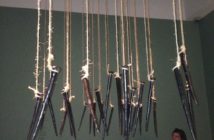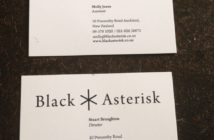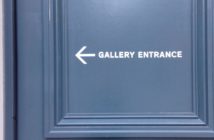We don’t use the supposedly Tauranga Direct Road to Rotorua. Avoiding the twists and turns today we go across to Rotorua the easy way – down towards Whakatane and then cutting across. The weather is cold and clear and the road is great. Emma Frederickson and I of ARTbop are going to meet with Joanna Doherty of the Rotorua Museum Te Whare Taonga o Te Arawa and look over the exhibitions. The Museum, says it provides art, culture and heritage.
You can’t miss the Museum building it’s faux- Elizabethean, English country house style (originally built as a destination resort and bath house for taking the waters and the mud) dominating its surrounding garden landscape. And that’s the next thing you notice – the outstanding garden presentation and environmental cleanliness. Everything looks as though it’s just been cleaned or gardened. We park near what is still called “The Gardener’s Cottage” again with its New Zealand interpretation of an English house garden.
We go into the Museum through its cafe and it’s here we meet with Jo Doherty of the Museum. It’s 10 am so over a coffee we talk through what ARTbop is hoping to do promoting the arts in the wider Bay of Plenty. To our left are reminders of the recently concluded project and exhbition On the Wing the karearea, the endangered New Zealand falcon. Jo backgrounds us as to the variety and diversity available within the Museum, its exhibitions and permanent features. Two things immediately stand out – firstly that there are five galleries with changing exhibitions plus permanent exhibitions and secondly they have 80 volunteer guides.
The building is itself an exhibition. Around it sections of wall have been opened to expose construction or earlier finishes. This has also been done with accumulated paintwork. Examples of the original Bath House facilities have been preserved and you can see, baths, tilework, primitive electrical therapy equipment and the mud baths in the basement. We’re given a beautiful historical publication “Taking the Cure: The story of the Rotorua Bath House” which has reproduced on its outer back cover a fragment of a letter from Smith & Caughey Ltd about the cost of towels! If you’re minded to you can also got up to the viewing platforms of the roof for views across Rotorua.
As you walk around the museum there are numerous traditional, classical, marble sculptures The Summers’ Sculptures “purchased in 1908 by the Department of Tourist and Health Restorts to add to the ambience of the then Rotorua Bath House. They are an integral part of the history and heritage of the building as is the architecture and the decoration.
The day Emma and I are there it’s school holidays. The Museum was running holiday drop in crafts programmes; free with Museum admission (I was also shown one of the results of the creative craft workshop). The programme seemed to include finding the John Roy, Tauranga -Safety in Numbers suite of installations located around the buiilding and not always where you’d expect them. I get to view the rats again, high on a wall on the ground floor. With paper and pencil in hand groups of children were searching, learning and having fun at the same time. We met them in the corridors, in the foundations, striding up the stairs to the roof – all totally enthused.
Now, here’s a “tasting plate” of what else we saw during our time at the Rotorua Museum:
It’s just the tiniest bit scary when the style of clothing you wore as a teenager is being shown as representative of a vintage revolution – the “Age of Aquarius A 1970s Revolution in Fashion” from The New Zealand Fashion Museum. This was a comparatively small exhibition of both retail, designer and homemade clothing, shoes and bags of the 1970s.
The list of works says “This exhibition provides a platform to see and experience New Zealand in the 1970s…. this was a time when radical changes and protests of the late 1960s impacted on society more broadly….The New Zealand Fashion Museum encourages you to look not just to the past in viewing this exhibition, but also to reflect on how many concerns of the 1970s persist today…” Another dimension on the world of fashion and clothing. Take a look at www.nzfashionmuseum.org.nz
There is an extensive tangata whenua and cultural information display area – it’s not just for tourists, it would be an excellent overview for anyone – Nga Pumanawa o Te Arawa The Beating Hearts of Te Arawa includes He Tira Kahurangi A Group of Precious Women; the female guides of Whakarewarewa and B Company 28th Maori Battalion – there are walls of photographs and lightbox memorial walls.
Te Ara: Maori Pathways of Leadership (until 08 June 2014) features large scale photographs by Krzysztof Pfeiffer which have been shown worldwide.
Also on display until 08 June 2014 are sixty works by Dennis K. Turner A Continuous Line: The Art of Dennis K. Turner It’s a very big exhibition and it’s got examples of all of Turner’s styles from the highly representational woolshed scenes through to his much later abstracts and the batik-like Frizell forerunner hei tiki images. The Museum brochure says “…Over sixty works by this influential artist are presented together for the first time in a large scale survey exhibition curated by historian Richard Wolfe and toured by the Gus Fisher Gallery. The exhibiton includes 12 works from Rotorua Museum’s own collection.” If you’ve got the time before the 15 June to see nothing else at the Rotorua Museum, go and see this. It may take you an hour to travel there and an hour to travel back but you’ll be moving the whole time, it isn’t Auckland!
We saw Now and Then: Enduring and developing themes in contemporary New Zealand photography (since closed) which I recall seeing at the Tauranga Art Gallery. It’s an exhibition exploring trends and themes of fine art photography from 1969 to 2011. The exhibition was developed and toured by Te Manawa Museum of Art, History and Science. And, Mirror Mirror (since closed) a range of portraits from the Rotorua Museum Collection showing the diverse approaches New Zealand Artists have taken to portraiture over the years. And there is a large Jan Nigro I would like to take home.
If anything Emma and I have probably done the Museum at speed. You could spend the entire day in there and still not see everything the permanent exhibitions and changing galleries have to offer. We didn’t see the Rotorua Stories Cinema (every 20 minutes from 9.00am) or the Maori Battalion Cinema (every 30 minutes from 9.30am). If you would like to be taken through the Museum, guided tours run every day on the hour from 10am to 4pm over the winter months and 10am to 5pm in summer. Group tours can also be arranged at other times.
What does it cost? I’m delighted to see the acknowledgement of single parent families $28. for 1 adult and up to 3 children. $45. for 2 adults and up to 3 children. A child from 5 to 15 years $5. Adults $20. and Seniors $18. I didn’t ask whether they did gift vouchers but a gift of museum admission and a petrol voucher to a limited income family could ultimately be as important as a foodbank loaf of bread. Where is our cultural foodbank?
The Museum is open every day except Christmas Day from December – February (Summer months) from 9am to 6pm and from March to November (Winter months) from 9am – 5pm.
From 24 May to 24 August 2014 the Rotorua Museum is showing the retrospective exhibition His Own Steam: The Work of Barry Brickell. This exhibition spans five decades of Brickell’s often quirky work. It is toured by The Dowse Art Museum. From 2 July – 2 November 2014 Great War Stories Rotorua Remembers World War One This exhibition tells some of the many powerful and diverse stories from World War One through objects and memories contributed by the Rotorua community.
As we leave we check out the Museum Shop – this has lots of things a tourist and a local visitor would buy. Then we walk into the warm sunshine in front of the Gardener’s Cottage to sit and eat.
Next, we head over to the Tuscan-styled building which is the Blue Baths. Recent building and design trends tend to obscure the age and Spanish Mission lorigins of this imposing building. The shallow pool visible from the foyer has been transformed into a dining and peformance area. The functioning Blue Bath is visible through the heavy wood and glass doors – the originals. There’s a price list for swimming – $6.00 a child, $11.00 an adult and $30.00 a family.
Once again an exhibition has been created of the buiilding itself and its former use. The old changing cubicles are now artifact and information displays – some of the bathing suits resemble the woollen “costumes” brought from England by my late parents.
In the foyer I find promotional material for Creation Fest 2014 with its live shows on 15 -19 July “experience mind-blowing wearable art, breath taking live performance and innovative short films. 5 shows. 3 elements. We dare you not to be wowed.” There’s even a Madhatter Matinee on Wednesday 16th July from 11am to 2pm – Create a Hat for Creation Fest www.creationfest.co.nz
Note: Emma Frederickson and Rosemary Balu of ARTbop requested and were provided with their admission to the Rotorua Museum. The above article by Rosemary Balu incorporates quotations and phrases of text from a variety of Rotorua Museum educational brochures and promotional material publically available at the Museum.





